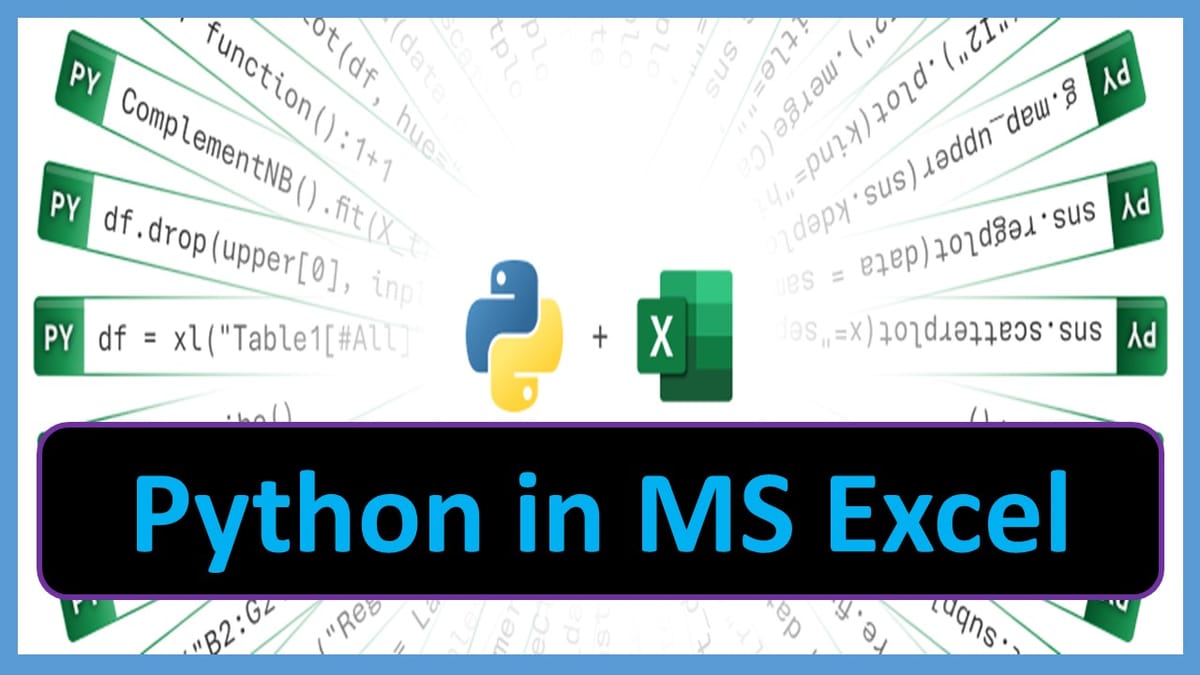You can now utilise the power of Python in your favourite Excel spreadsheet by typing just the simple code "=PY(", followed by the Python code. This PY function will give you access to all the major functions and libraries of Python.
AASHISH KUMAR JHA | Sep 20, 2023 |

Python in MS Excel: Experience the Next-Level Data Analysis, Take your Productivity to New Heights
Python in MS Excel: Have you ever imagined what could possibly happen if you combine the power of two of the best in their fields? It will create a new product which will be highly powerful and extremely productive. This is not a dream in the technology world, it has already taken place. You can use Python in MS Excel now to take your skills to a higher level. Microsoft and Python Anaconda unveiled a ground-breaking invention: Python in Excel. This represents a change in the working methods of Excel users and Python experts. This expands the data analysis possibilities available to Excel users, which was previously only available to data scientists and developers.
Excel is a vital tool for gathering, arranging, and analyzing many types of data, and Python is one of the most widely used programming languages today. You may build strong and adaptable data analysis and visualization solutions by integrating the two. The Anaconda Distribution for Python’s integration with Microsoft Excel is more than just a feature; it redefines what is possible in data analytics. It bridges the gap between powerful data science and standard business tools by fusing Python’s extensive capabilities with Excel’s comfortable interface. You won’t need to do any setup in order for this integration to function because it is entirely native to Excel.
You can now utilize the power of Python in your favourite Excel spreadsheet Excel by typing just a simple code “=PY ()”. You can immediately evaluate Python code in an Excel cell using this method. You have to write `PY(`, followed by your Python code). This PY function will give you access to all the major functions and libraries of Python. You will be able to analyze many complex data sets in less time.
Advantages of Using Python in MS Excel
Your data analysis procedures become more flexible when you use Python in Excel. Let’s look at some effective changes you can make to your routine workflow.
1) Increased Efficiency
Excel’s inability to manage vast amounts of data is one of its drawbacks. When using Excel to conduct complex operations on a large number of data entries, you may experience major performance problems, especially if your formulas and macros are not performance-optimized. Now utilizing the power of Python in MS Excel, you can perform complex data analysis with less effort. This will help you take your productivity to new heights.
2) Advanced Data Visualizations
Advanced visualizations should also be possible thanks to Microsoft’s collaboration with Anaconda, a Python repository that houses well-known tools like Matplotlib, pandas, and scikit-learn. By leveraging the power of these powerful libraries in your Excel spreadsheet, you can do comprehensive and more advanced data analysis.
3) Increased Productivity
Excel’s inability to manage vast amounts of data is one of its drawbacks. When using Excel to conduct complex operations on a large number of data entries, you may experience major performance problems, especially if your formulas and macros are not performance-optimized. But now using Python in your Excel workbook, you can perform complex data analysis with less effort, thus increasing productivity.
4) Deep Statistical Analysis
The combination of MS Excel and Python will help you perform deep statistical analysis with ease. You can utilize Python’s robust libraries, such as pandas and statsmodels, to improve your analysis. Complete statistical activities can be completed right inside the Excel cells. You don’t need to be an expert in data science to use advanced analytics because Anaconda’s carefully selected Python libraries are incorporated in Excel.
5) Increased Speed
Excel might take a lot of time if you have to complete repetitive tasks. For instance, you would have to manually access each Excel file and copy-paste the identical formulas each time you want to replicate an analysis across many Excel files each week. By leveraging the feature of Python in MS Excel, you can complete all these tasks in seconds.
6) Rich Python Libraries at your Fingertips
This feature includes the extensive ecosystem of Python libraries in addition to bringing Python inside Excel. The availability of libraries in Excel such as Pandas for data processing, statsmodels for sophisticated statistical modelling, and Matplotlib and Seaborn for data visualization opens you a world of new possibilities for your spreadsheets.
You may develop robust and adaptable data analysis and visualization solutions by integrating Python with Excel. For data analysis, machine learning, and visualization, Python offers a large selection of libraries and tools, but Excel offers a recognizable and user-friendly interface. By combining both these powerful tools, you will be able to perform all your work with less effort.
In case of any Doubt regarding Membership you can mail us at contact@studycafe.in
Join Studycafe's WhatsApp Group or Telegram Channel for Latest Updates on Government Job, Sarkari Naukri, Private Jobs, Income Tax, GST, Companies Act, Judgements and CA, CS, ICWA, and MUCH MORE!"